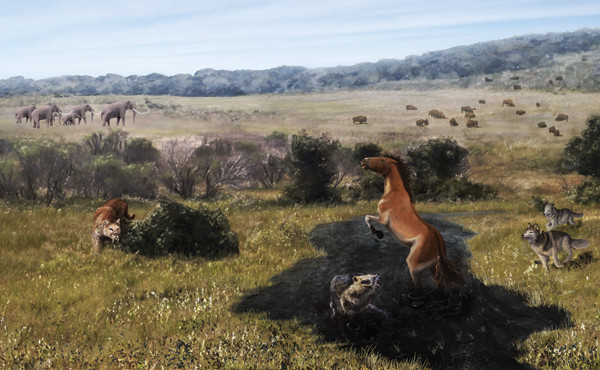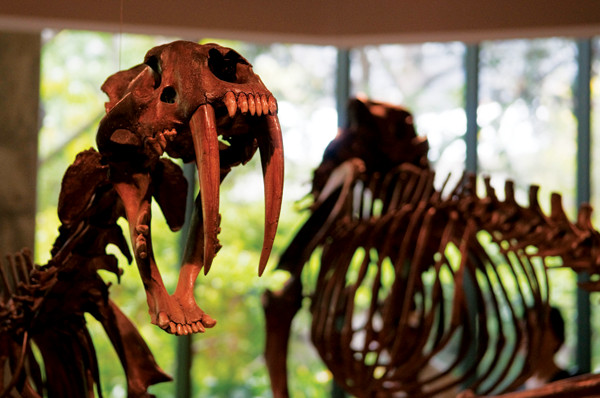
by Mary Caperton Morton Wednesday, July 9, 2014

New research on bones at the La Brea tar pits suggests saber-toothed cats (at right) grew larger as the climate warmed toward the end of the last ice age, whereas dire wolves grew smaller. Credit: Kathleen Cantner, AGI.
“The most attractive thing about working at the tar pits is the sheer quantity of fossils,” says Robin O’Keefe, an evolutionary biologist at Marshall College in West Virginia and lead author of the dire wolf study, published in Palaeontologia Electronica. “Instead of just studying individuals, we can actually ask population-level questions about how these animals evolved.”
To study the changes in dire wolves at the tar pits over time, O’Keefe and co-authors used digital morphometrics — a 3-D imaging technique used to measure the size and shape of 73 dire wolf skulls found in four different pits dating to between 28,000 and 13,800 years ago. They found that dire wolves in the youngest pit, which was active when the climate was warming at the end of the Pleistocene, were noticeably smaller and more slender than the older specimens from colder time periods. Despite their smaller size, the wolves seemed to be healthy, as indicated by having few broken teeth, which are subject to increased wear as starving animals resort to gnawing on bones for sustenance.
“We found that in this warm interval right before the Pleistocene extinction, dire wolves were relatively happy — not under great nutritional stress — and quite small,” O’Keefe says. This trend is also seen in modern gray wolves, which tend to be smaller in warmer, more southern habitats, he says.

Saber-toothed cat skeleton. Credit: Page Museum.
So why were dire wolves getting smaller while saber-toothed cats were getting bigger? “That’s the most fascinating question to come out of this research,” says O’Keefe, who was a co-author on the saber-toothed cat study. “As of right now, we don’t know the answer.”
Both dire wolves and saber-toothed cats are thought to have been highly social animals that hunted in teams, making a behavioral explanation for their size divergence unlikely, says Larisa DeSantis, a paleoecologist at Vanderbilt University who was not involved in either of the new studies. “The fact that we’re seeing different patterns may mean they were specializing in different types of prey. Often animals that occupy a similar niche can coexist by exploiting slightly different resources,” she says.
Answers may also be found by studying La Brea’s herbivores, says Graham Slater, an evolutionary biologist at the Smithsonian’s National Museum of Natural History in Washington D.C., who was not involved in the new studies. “La Brea is a tremendous resource for those who study carnivores, but it’s challenging to put it in a broader ecologic perspective without knowing much about the herbivores they were eating,” he says. “A better handle on the relative abundance of horses and bison will be important for understanding these carnivore dynamics.”
Next, O’Keefe and Meachen plan to team up to work on a more thorough dating study of the different pits at La Brea, with the goal of adding more skull and jaw samples from different time periods. “Climate was extremely variable throughout the Pleistocene so it will be interesting to look at skulls from other warmer periods and see if we find the same patterns in size,” O’Keefe says.
The work may help answer the ultimate question about the Pleistocene extinctions: Did climate change or overhunting by humans or some combination of both wipe out the dire wolves, saber-toothed cats and other megafauna at the end of the last glaciation? The answers may have some implications for modern predators as well, Meachen says. “We can also apply what we learn about how ecosystems coped with the end of the Pleistocene to what’s happening with climate change today.”
© 2008-2021. All rights reserved. Any copying, redistribution or retransmission of any of the contents of this service without the expressed written permission of the American Geosciences Institute is expressly prohibited. Click here for all copyright requests.